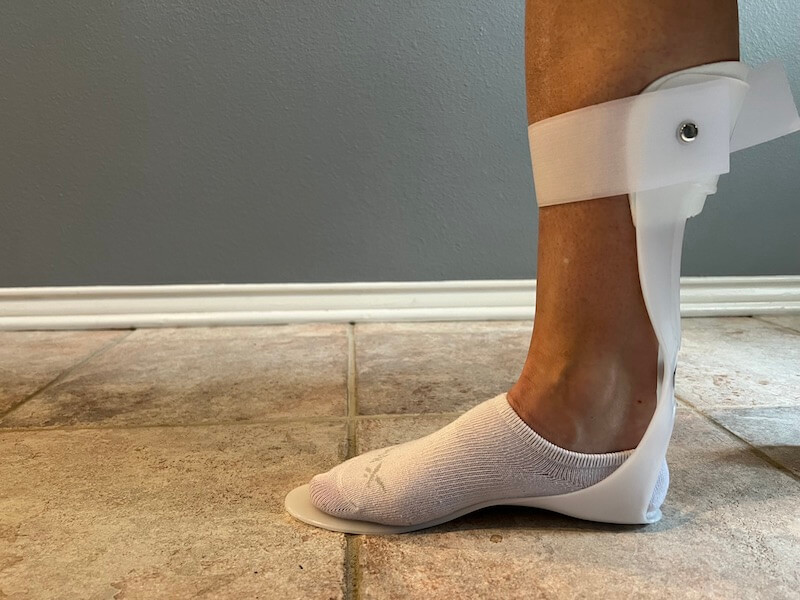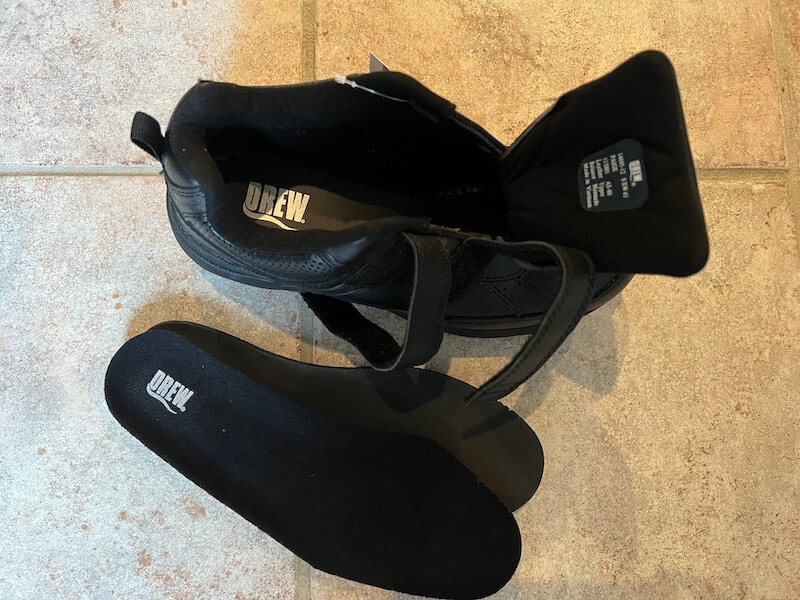free shipping desktop
Guide For Selecting & Using Shoes With An AFO Brace

If you are new to wearing an Ankle-Foot Orthosis (AFO) brace, you may face challenges finding shoes with sufficient depth and space to accommodate the brace. You may have noticed not many shoes provide enough depth or interior space to accommodate the brace. The right shoe can make a significant difference in comfort, mobility, and the effectiveness of the AFO itself. However, navigating the countless footwear options, modifications, and considerations necessary for an AFO-compatible shoe can be unclear.
This article guides you through choosing the right shoe for your AFO brace and simplifies the wearing process. We'll explore how to select shoes that not only fit well with your AFO but also support your specific needs, ensuring both comfort and functionality. While it's crucial to understand that the information provided here is not medical advice, it is guided by extensive experience in pairing orthopedic shoes with various types of braces and orthotic devices. Whether you're dealing with foot drop, post-stroke recovery, or any condition that necessitates the use of an AFO, finding the right footwear can be a pivotal step in your journey toward improved mobility and quality of life.
Choosing the Right Shoe for Your AFO Brace
When it comes to integrating an AFO brace with footwear, the right shoe can significantly enhance comfort, mobility, and the effectiveness of the brace. Below are some shoe features to consider in selecting the most suitable footwear for your needs.
Wide Opening and Adjustable Closure
A shoe that features a wide opening make it easier to insert the foot with the brace into the shoe without compromising the structure or support of the AFO or the shoe. Some shoe styles offer a heel-entry flap that folds down so you can insert your foot without having to angle your foot in the shoe. This can be help if you have limited range of motion at the ankle. Also, an adjustable closure, such as hook-and-loop straps or laces that can be easily be adjusted to fit the girth of the brace, is ideal for accommodating an AFO.
Deep and Roomy Toe Box
Opt for shoes with a deep and roomy toe box. More space at the toe box area ensures that you have enough room for the brace to fit properly in the shoe without too much pressure or force on the foot and brace. This is also important even if you do not have wide feet because the AFO can alter the way your foot sits inside the shoe and may require the added interior space. A cramped toe box can lead to pressure points and discomfort, impacting your mobility and the health of your feet.
Firm Heel Counter
A firm heel counter—the part of the shoe that wraps around the back of your heel—is important for stability. With an AFO, your foot's movement and positioning are different from the norm, and a firm heel counter helps in providing the necessary support and alignment, reducing the risk of the shoe slipping off.
Removable Insoles and Extra Depth
Shoes with removable insoles (preferably two or more) allow you to adjust the depth of the shoe as needed. Additionally, shoes designed with extra depth or double depth can accommodate the additional bulk of an AFO without forcing the foot into a tight space, maintaining comfort over prolonged periods. In some cases, you may need to remove all inserts in the shoe to allow more room for the brace to ensure a proper fit.
Durable and Supportive Sole
Look for a shoe with a durable sole that provides good traction and support. A non-slip sole is essential for safety, particularly for those who may have challenges with mobility or balance due to their condition. The sole should also offer enough cushioning to absorb impact without being too thick or inflexible, as this can affect the shoe's compatibility with the AFO.
Upper Materials
Breathable materials, such as leather or high-quality synthetic fabrics, can help in managing moisture and keeping the foot comfortable throughout the day. Materials that offer a degree of stretch, such as a knit fabric or Lycra® material, may also accommodate the AFO better, adjusting to its shape and size.
Selecting the right shoe for your AFO brace involves considering these aspects to ensure a good fit, adequate support, and comfort. It may be helpful to visit a specialized footwear retailer or consult with a professional experienced in orthopedic shoes and AFOs to find the best options available. Remember, the goal is to enhance your mobility and comfort, so taking the time to choose the right shoe is a crucial step in achieving the best outcome with your AFO brace.
Step-by-Step Guide to Putting on A Shoe with an AFO
Once you have found a shoe that offers the features mentioned previously, you are ready to try on your new shoes with your brace. Below are the steps to properly put on a shoe with an AFO.
Step 1: Prepare the AFO and Shoe

Before attempting to put on your shoe, ensure that the AFO is correctly positioned on your leg. The brace should be snug but comfortable, with no pinching or excessive pressure on any part of your leg or foot. Your heel should fit securely against the back of the AFO and your toes should be able to spread out naturally.

Your shoe should meet the criteria for AFO compatibility – wide opening, removable insoles, and extra depth, etc. Loosen the laces or straps on the shoe and pull the tongue forward to make the opening for the shoe as wide as possible. Remove all inserts in the shoe at first. You can add back any additional inserts if the shoe feels too loose after putting on.
Step 2: Insert the AFO into the Shoe
Angle the AFO and foot as needed into the opening of the shoe. It may be helpful to slightly tilt the shoe or use a shoe horn to guide the foot into the shoe and ease the heel past the back of the shoe.

Gently press down on your knee to fully seat your foot and the AFO into the shoe. You shouldn’t put too much force on the back of the shoe to avoid damaging the heel counter and compromising the heel support. If the shoe feels too tight or requires too much force for entry, the shoe may not be compatible with your brace.
Step 3: Secure The Shoe to the Brace

Once the AFO and foot are correctly positioned in the shoe, begin tightening the laces or straps. Ensure a snug fit, but do not overly tighten. If you are using laces, consider using alternative lacing techniques such as Bar Lacing or Skip-Lacing to provide more accommodating fit for the AFO.
Step 4: Check for Fit and Comfort
Do a final check for fit and comfort by taking a few steps with the shoe on. Ensure you do not feel tightness or pressure. Adjust the tongue of the shoe or make minor adjust to the closure if you feel some discomfort on the top of your feet. If the shoe feels loose, try adding additional inserts back in the shoe or tightening closures more securely.
Expert Tips to Wearing Shoes with AFO Brace
There are some common hurdles to overcome when attempting to pair an AFO brace with footwear. Below is a list of tips that may be beneficial in providing a better fit and comfort when wearing shoes with an AFO brace.
- Consider buyer longer replacement laces since AFO can be bulky and standard laces may be too short to fasten properly.
- Try alternative lacing techniques to accommodate the girth of an AFO brace.
- Consider a wider shoe width than your normal shoe width to accommodate the added bulk of the brace.
- Keep the insoles in the shoe for the foot without the brace.
- Pad any areas of the AFO that may cause irritation, using soft materials.
- Avoid shoes with gusseted tongues as the opening will not be wide enough for a brace.
- Consider a long-handled shoe horn to assist with sliding the foot and AFO into the shoe.
- Choose shoes made with durable materials to withstand the added stress and friction from the AFO.
- Regularly inspect and maintain both the AFO and the shoes to extend their lifespan.
Selecting and trying on a shoe with an AFO brace can be challenging initially, but with the right approach and a bit of practice, it becomes a manageable part of your daily routine. Remember, the key is ensuring both the AFO and shoe are properly prepared, aligning your foot comfortably within the brace, and making sure the shoe is securely fitted without causing discomfort. If you encounter persistent issues with fit or comfort, consulting with a professional experienced in orthopedic footwear or your healthcare provider is advisable to ensure your AFO and shoes are optimally aligned with your needs.
About author:
Derek Roach is a foot health expert with over a decade of experience in the orthopedic shoe industry. He has helped thousands of customers find the right footwear for their unique foot conditions. His expertise has been featured in major publications such as CNN, Women's Health Mag, HuffPost, and Healthline. Passionate about foot health and comfort, Derek provides practical advice to help people improve mobility and reduce foot pain through proper footwear choices.

